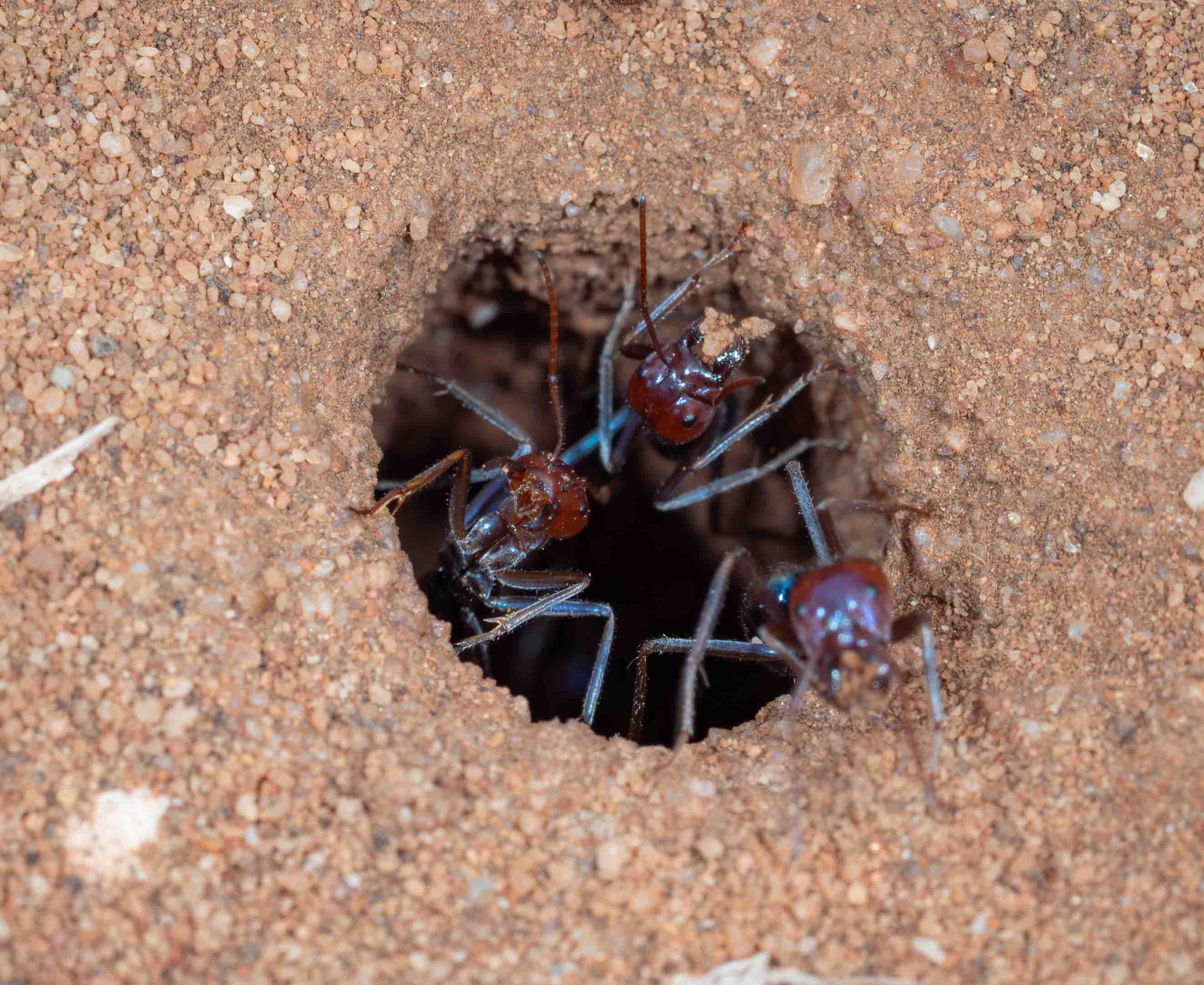
This Australian endemic is common and well known in most parts of Australia. Indeed, it is quite famous for the ability of colonies to rapidly dispose of large animal carcasses. Hence the common name 'meat ant'.
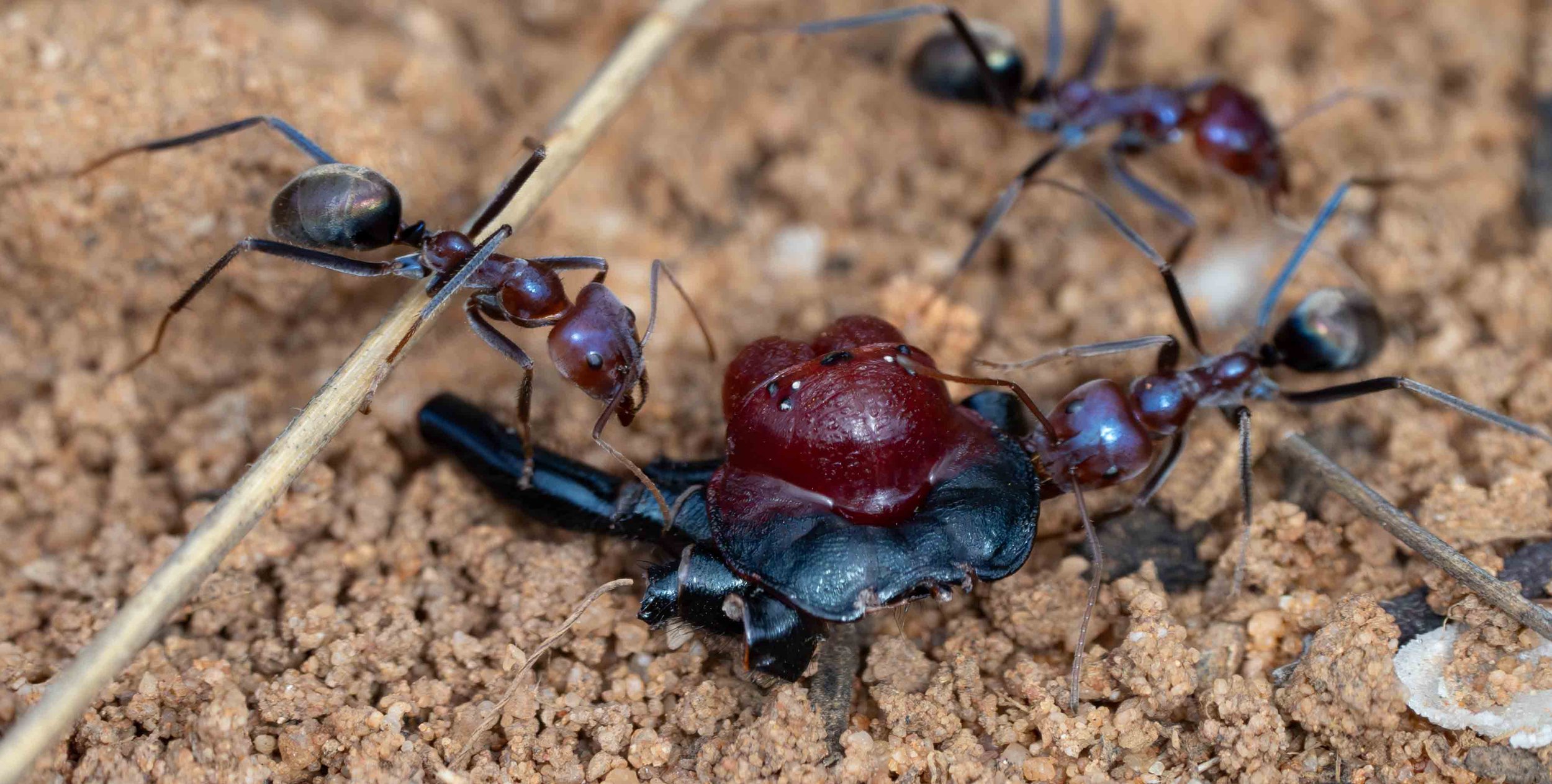
Meat ants, despite their name, are actually omnivores. Adults favour sugary liquids, such as those secreted by caterpillars and bugs. But they are also voracious collectors of protein to feed their young. Other invertebrates – dead or alive – are fair game. Was this mouse spider dead before the ants discovered it? Perhaps. Perhaps not.
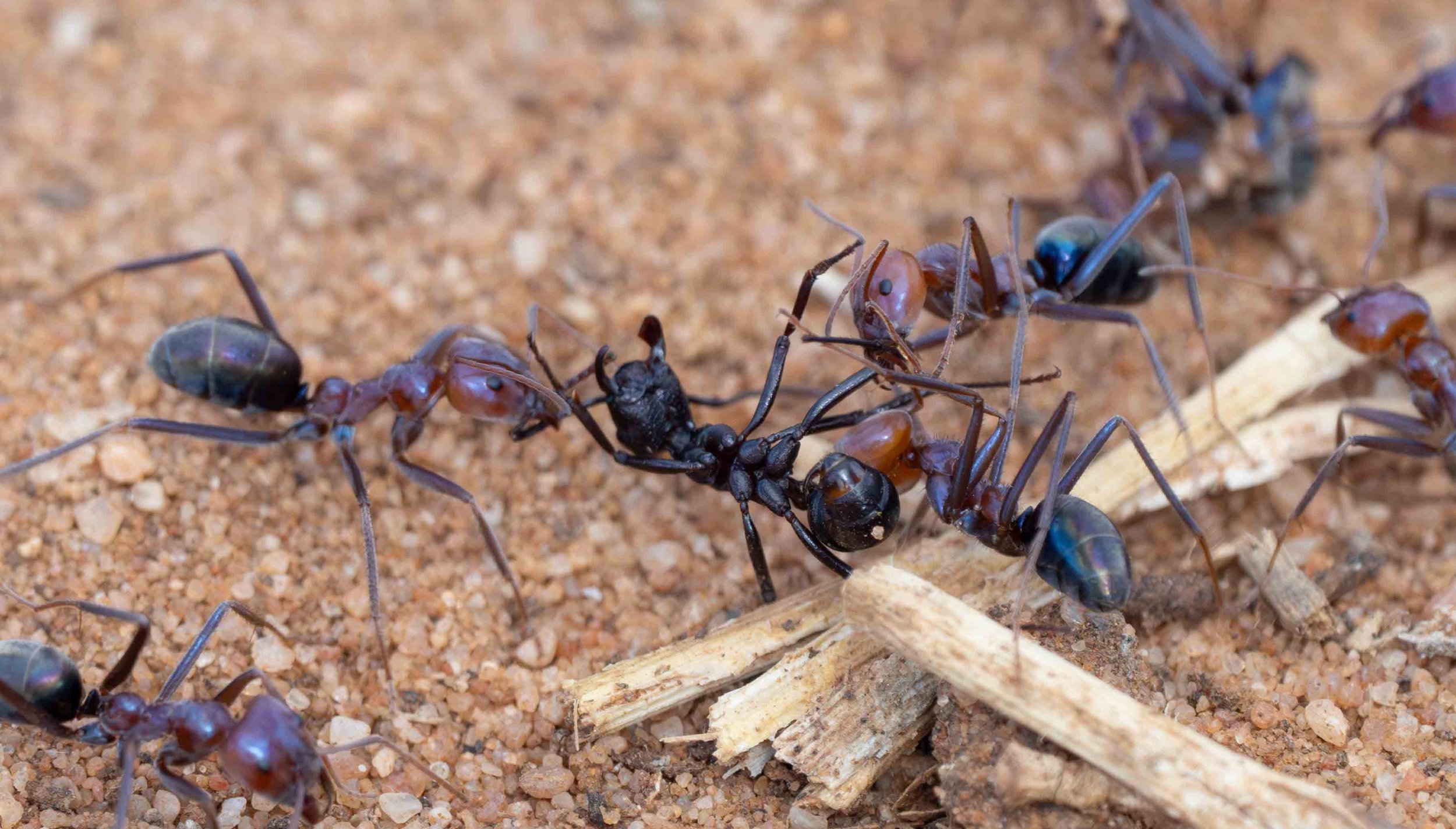
Meat ants are notoriously aggressive toward other, day-active ant species. The Titan Pony Ant here didn't stand a chance.
Although they don't sting, these ants can give a painful bite.
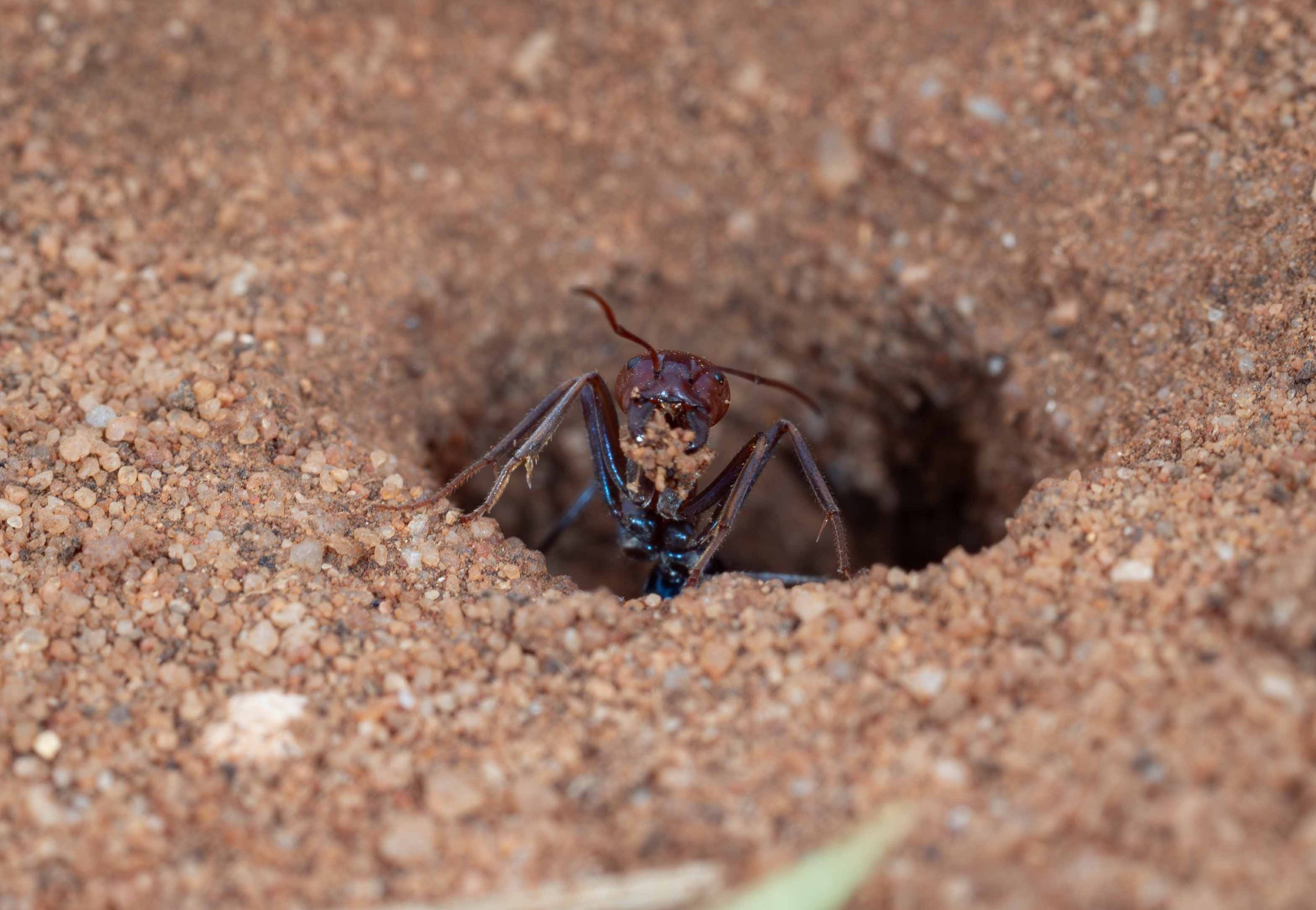
No obvious mounds, just very circular holes. And rather a lot of them!
In many locations, meat ants build huge mounds. But not always. A colony of this species in a similar environment (Morgan, SA) had nest mounds that were low or entirely absent, with just a sparse cover of gravel and twigs (ref. 1).
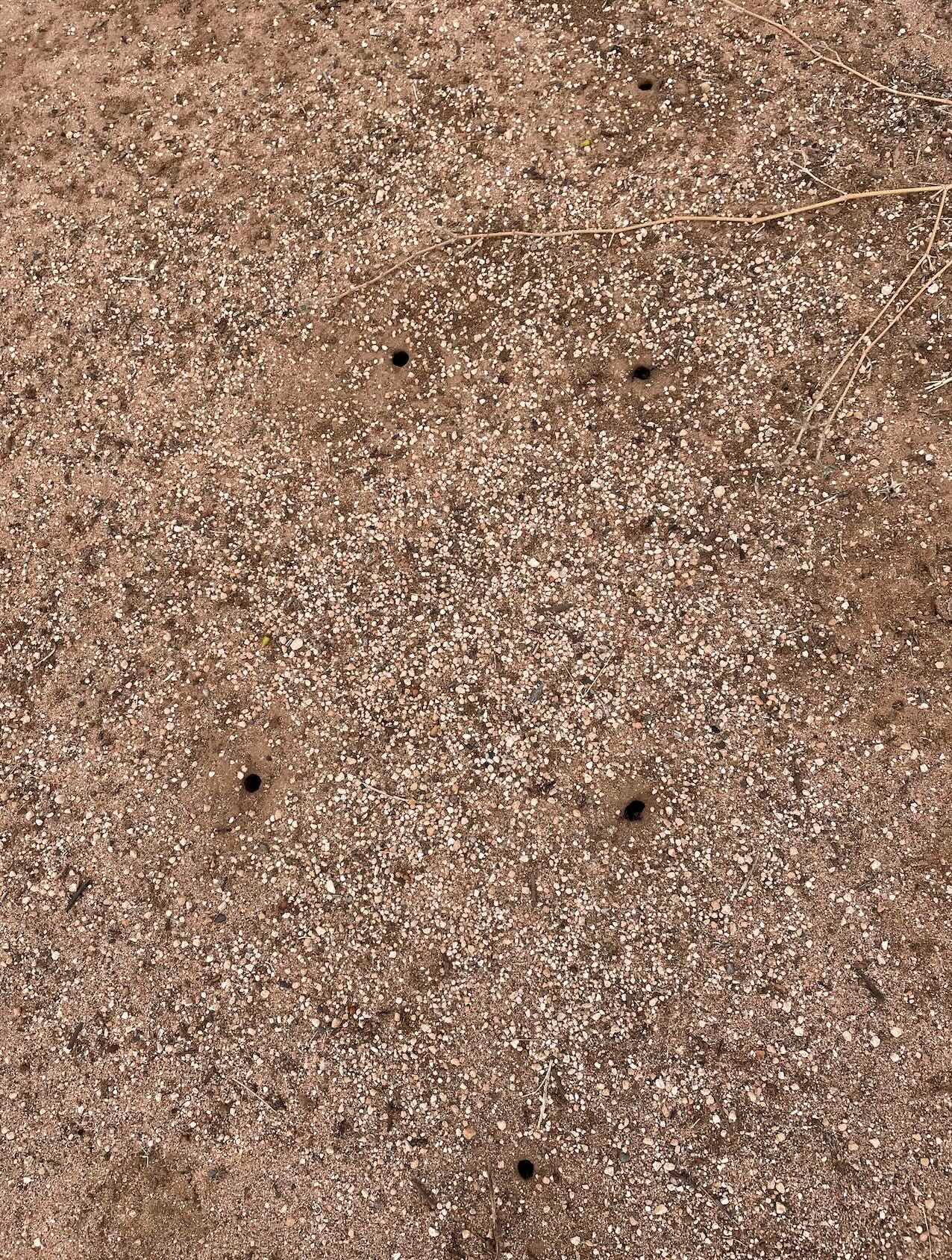
This species favours open, warm, sites with some nearby trees and vegetation. And the mallee country, including the driveway into the house block, is obviously perfect for them.
Meat ants can form huge colonies. A single colony may have numerous nests, each with multiple entrances, and linked by very obvious trails (ref. 1).
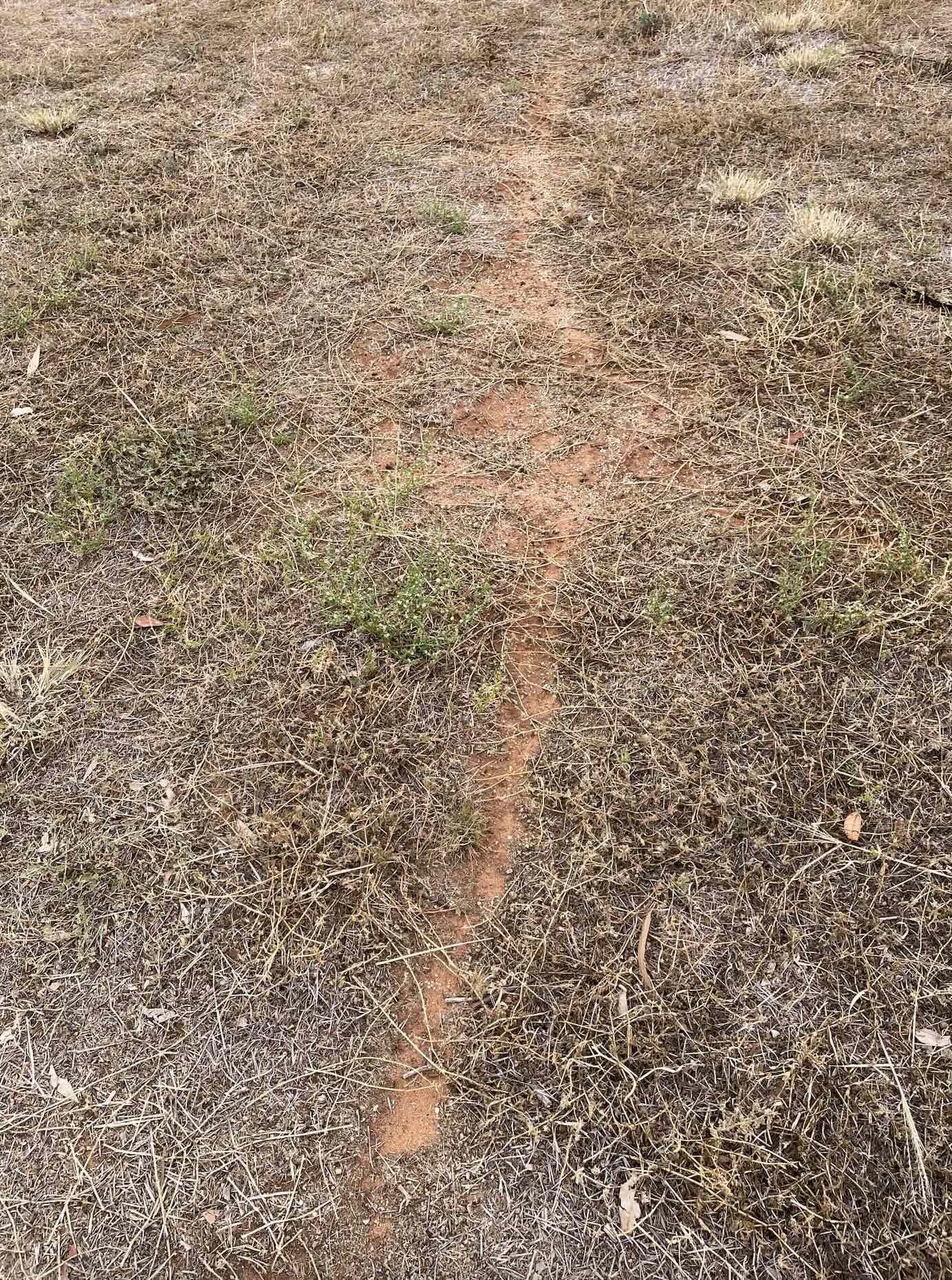
Meat ant trails! These very obvious tracks linked nests and probably also led to favourite foraging areas, such as nearby shrubs and trees.
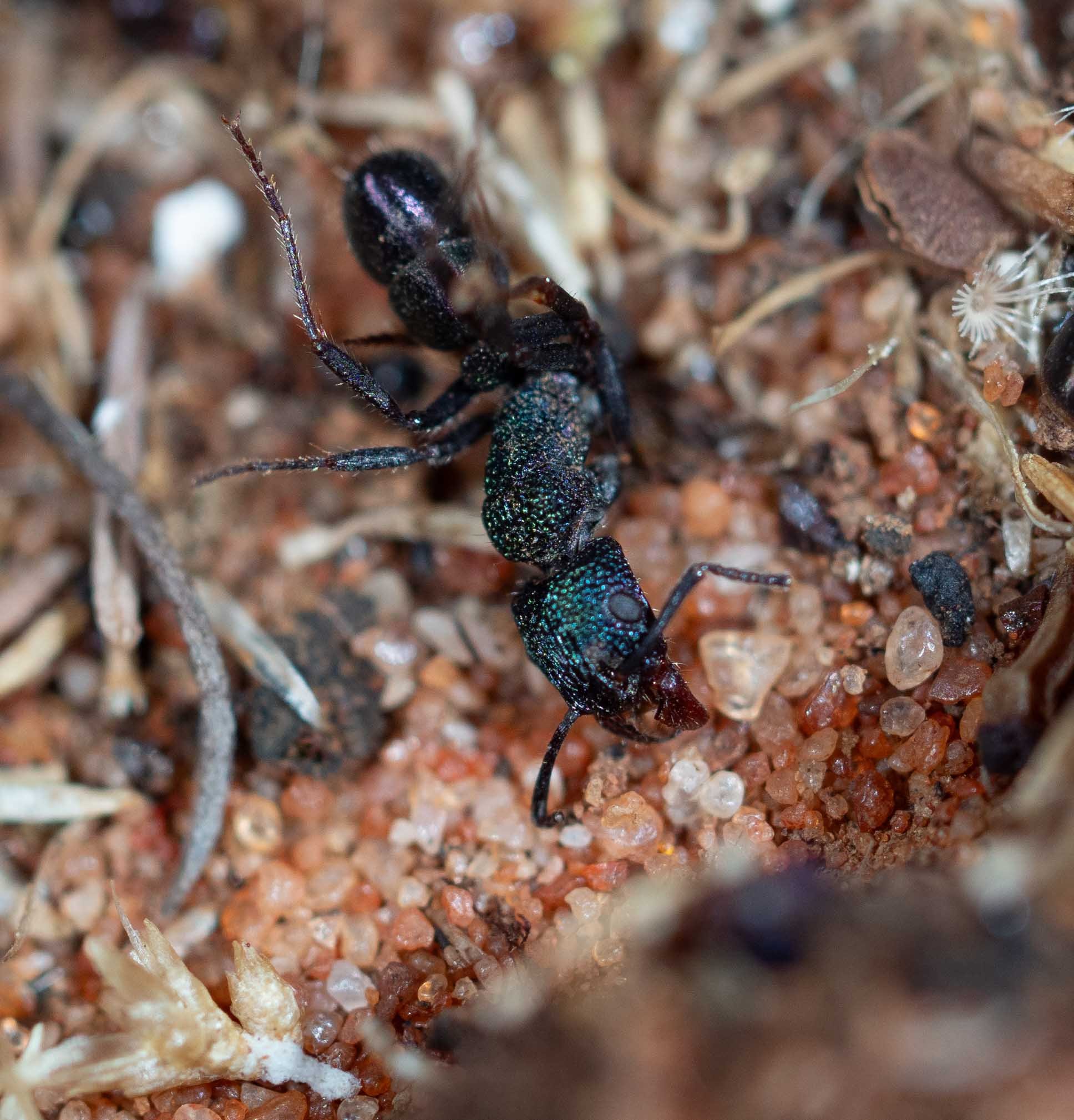
These tough-bodied little ants with the metallic sheen are a common sight across most of Australia. But unlike the meat ants, their colonies are often quite small. Indeed, we didn't see many individuals out and about. Also unlike meat ants, they can sting!
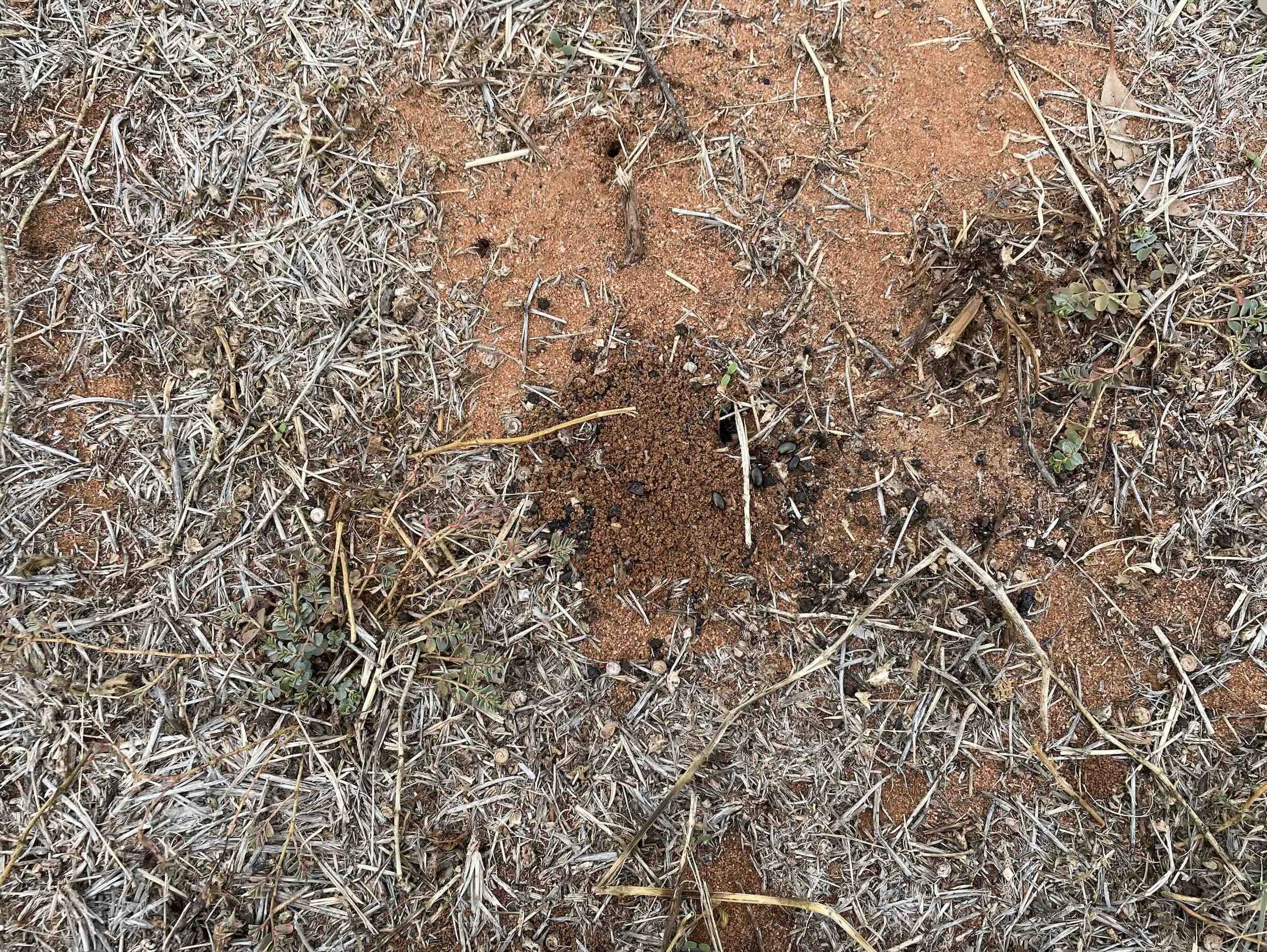
We found their nest on a little used track with a covering of dry vegetation. The low mound of excavated soil was less obvious than the collection of beetle carcasses surrounding it.
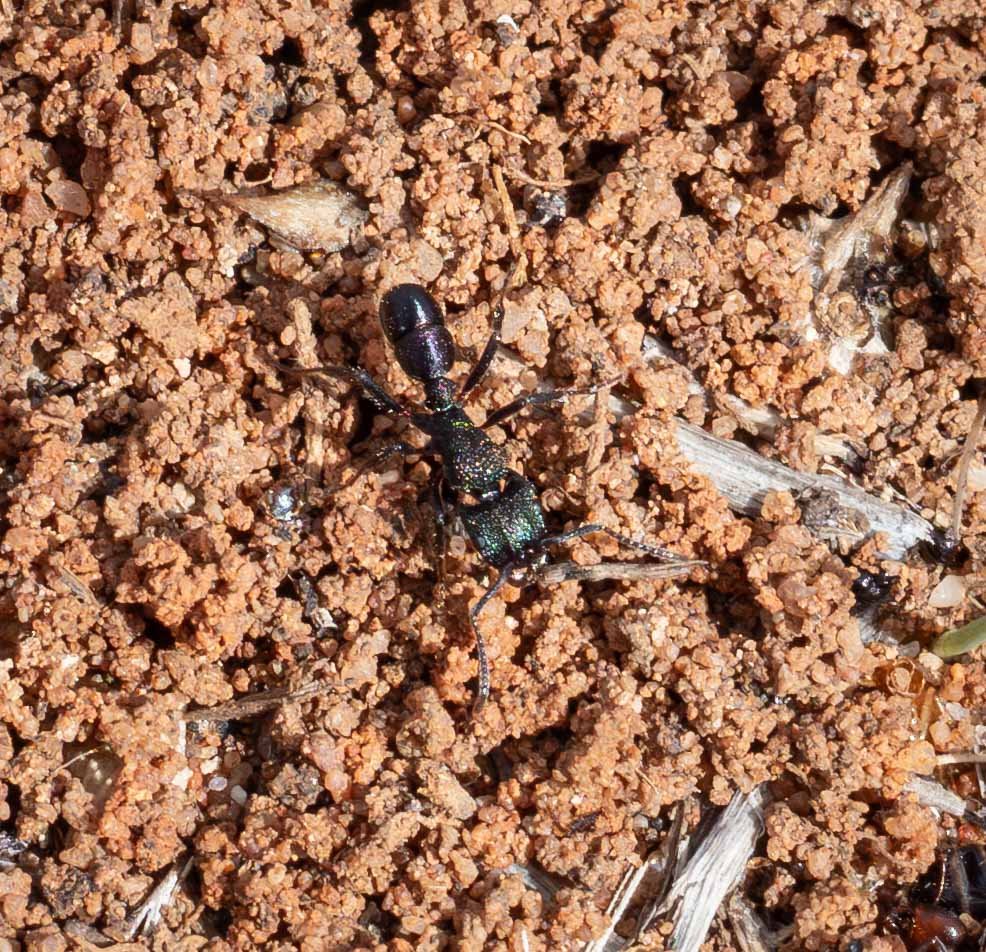
The literature on this species is extensive, their biology intriguing. Workers can mate and become reproductive, so colonies don't follow the typical 'single queen plus working daughters' model. And as colonies grow, the older workers tend to specialise in foraging while their younger nestmates stay home to care for the brood (ref. 2).
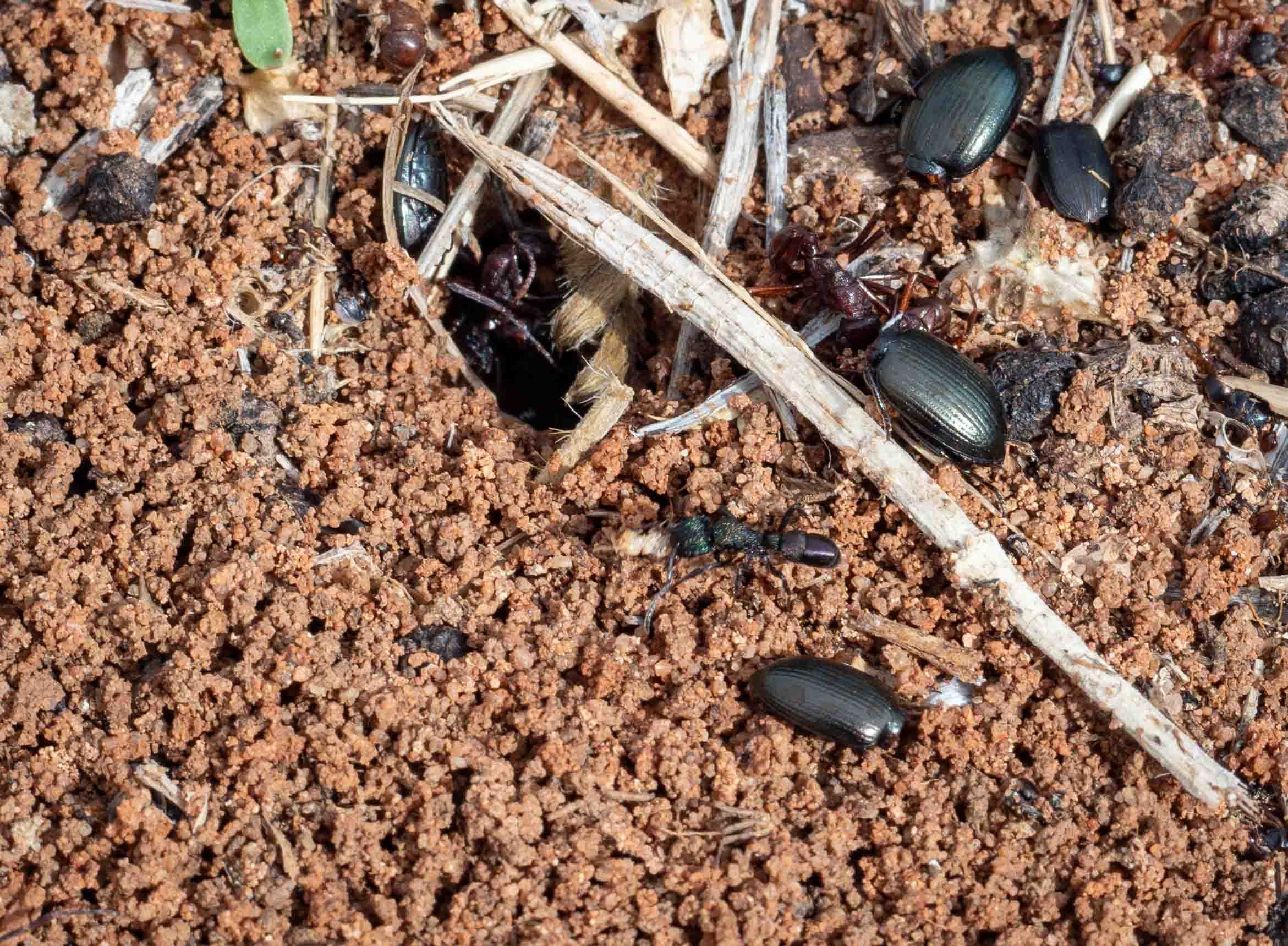
The nest opening was slightly obscured by grasses. Indeed, the reason we didn't see many active ants may be because they prefer to forage among vegetation. There they suffer less direct competition from their dominant neighbours, the meat ants (ref. 3).

These are large, long-legged ants. Despite their rather fierce appearance, they were not at all aggressive toward me. I actually had to tease them out of their nest opening for a photo ... this one I enticed onto a stick.
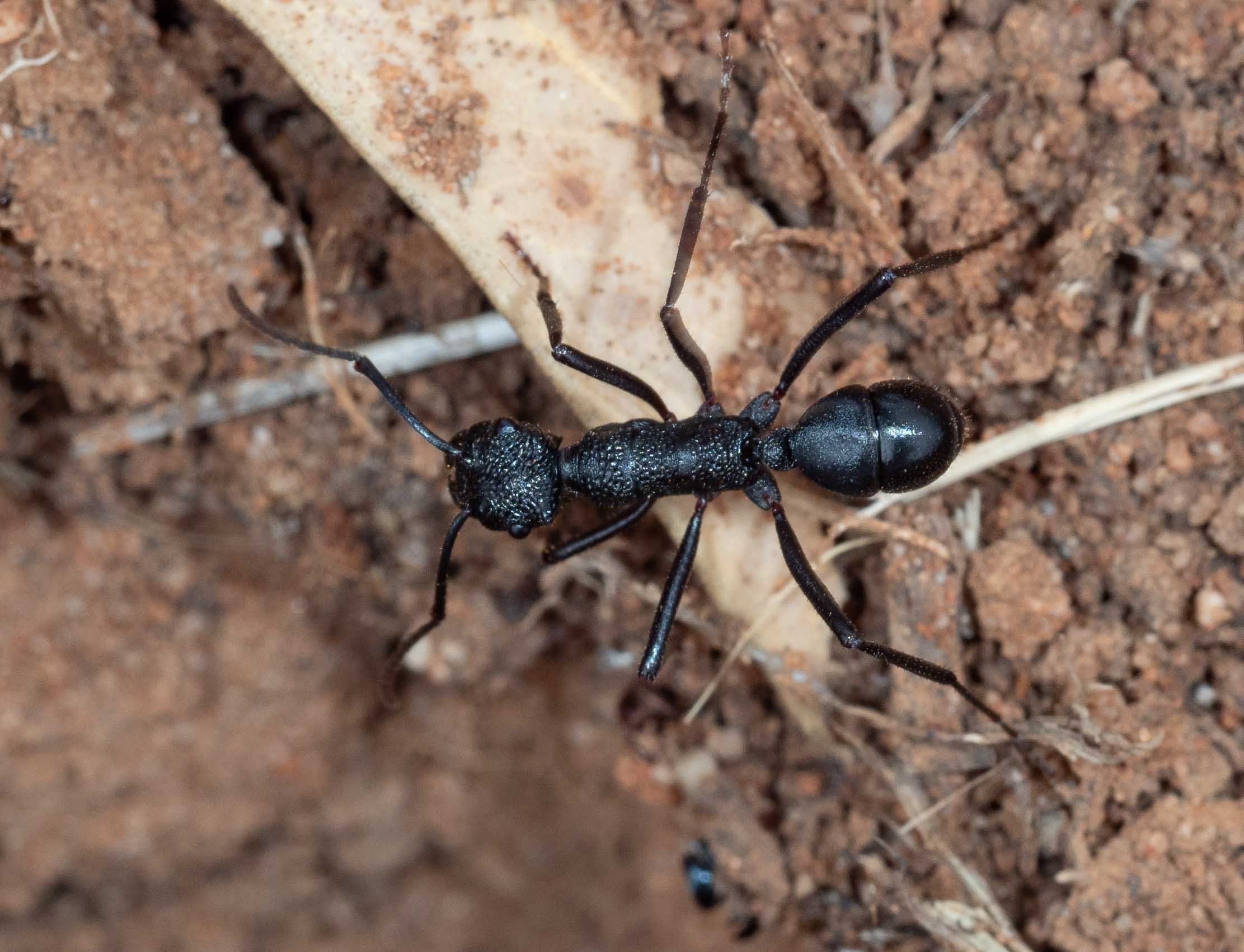
A relative of the Green-head Ant, and like their relatives they have a sting. And wrinkled-looking skin ... 'rhytid' is a medical term for wrinkles ... making this genus quite recognisable in the field (ref. 4).

This species does build an obvious mound. The opening was a ragged tear in the soil, the galleries visible just below the surface. This is consistent with descriptions of newly-established colonies. Mature nests extend around a metre below ground (ref. 5), so the galleries are less obvious.
Mature colonies may contain hundreds of workers (ref. 5) ... but not the thousands of meat ant colonies!
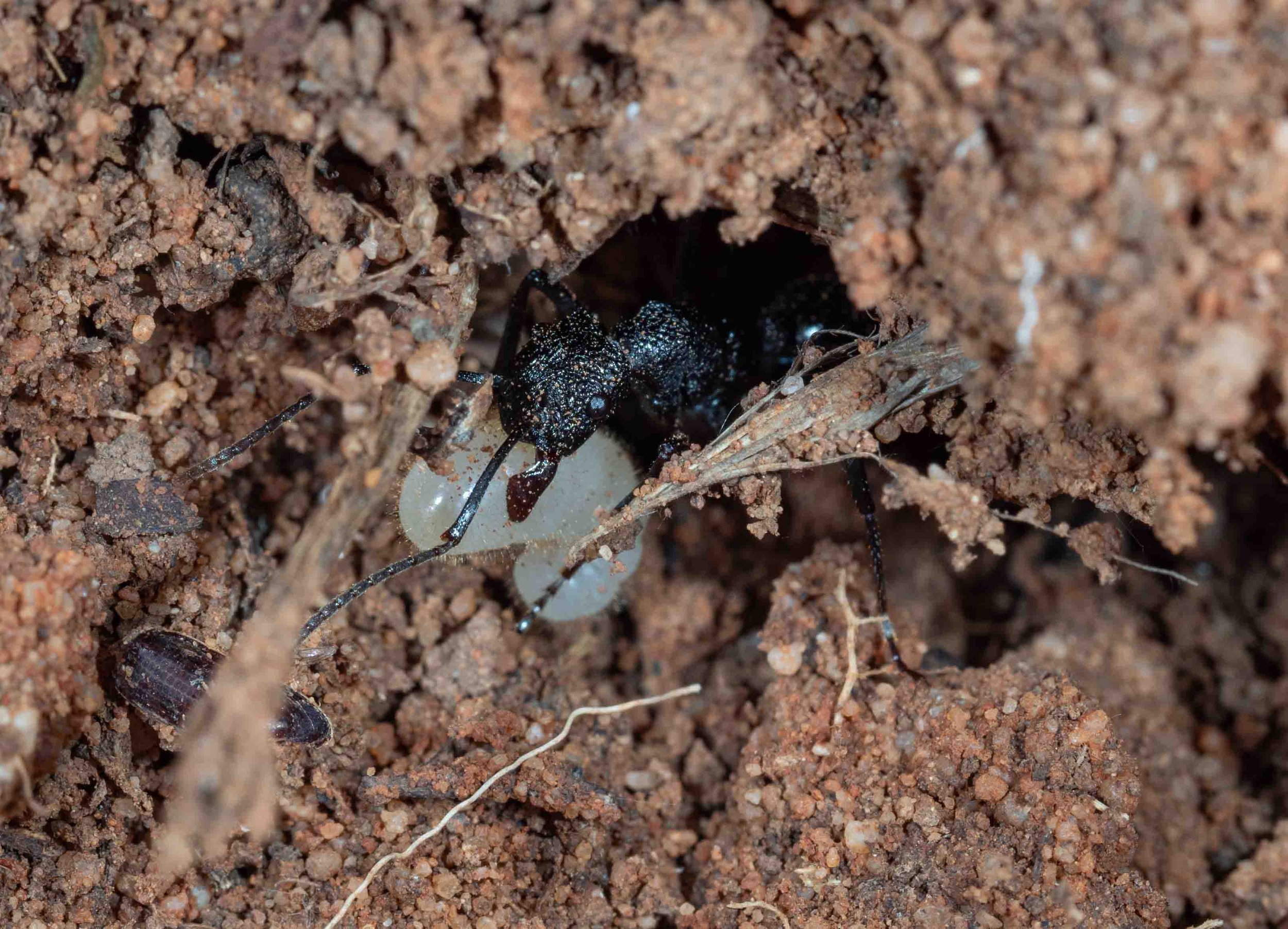
Just inside the nest opening, several workers were carrying larvae from one part of the nest to another.
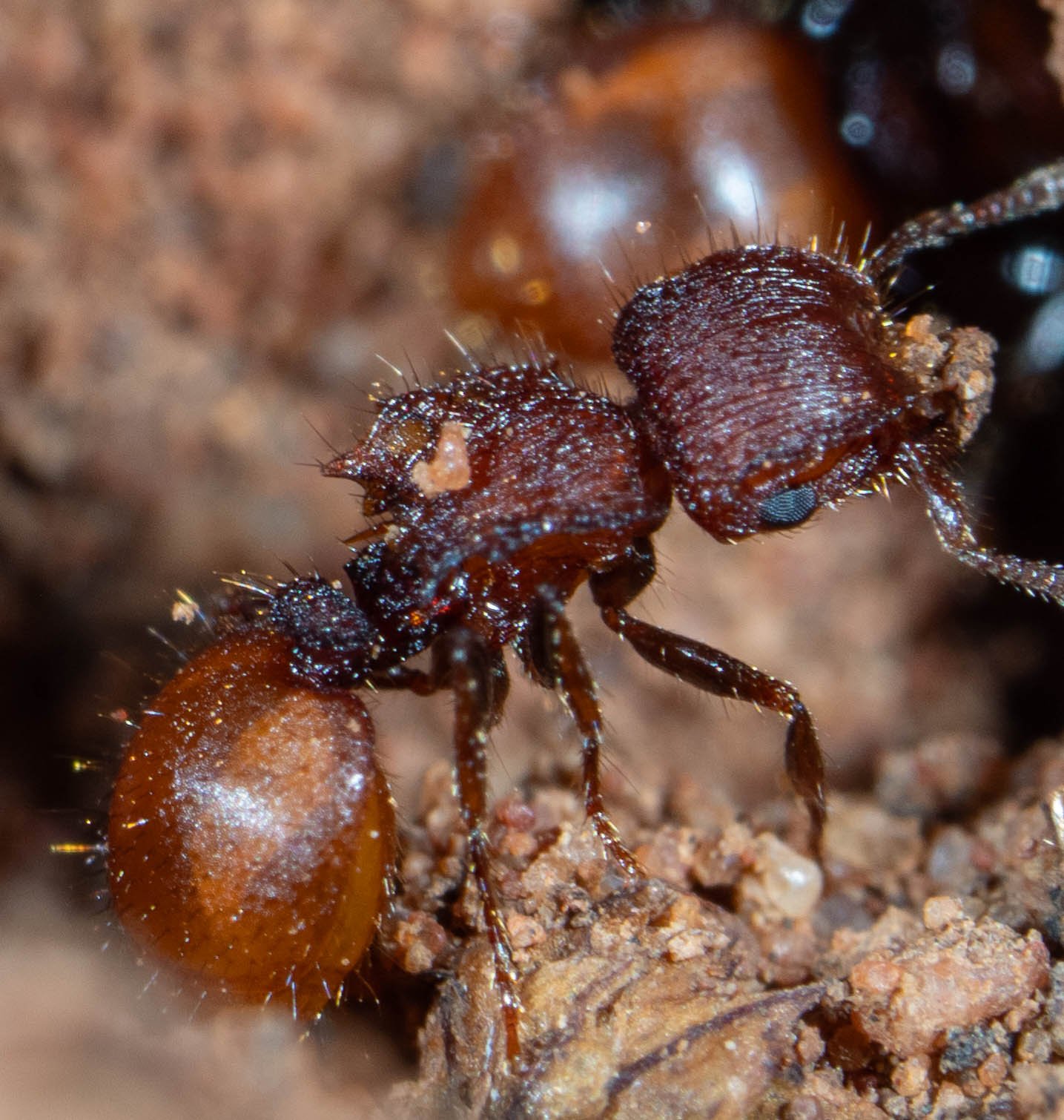
Rarely present in large numbers, these slow-moving ants are small and remarkably cryptic. When disturbed they 'play dead', curling into a ball with their antennae tucked away into grooves on their head. Soil caught in the hairs of their body provides further camouflage.

I'm sure I would have overlooked these little ants if Louise hadn't pointed them out to me. Their unusual appearance and behaviour had caught her attention some time ago, and she was curious to know more about them.
I was totally unfamiliar with them. Indeed, they tend to be uncommon in forests of the cool temperate zone (ref. 7). We have certainly never seen them in our home patch of SE NSW.
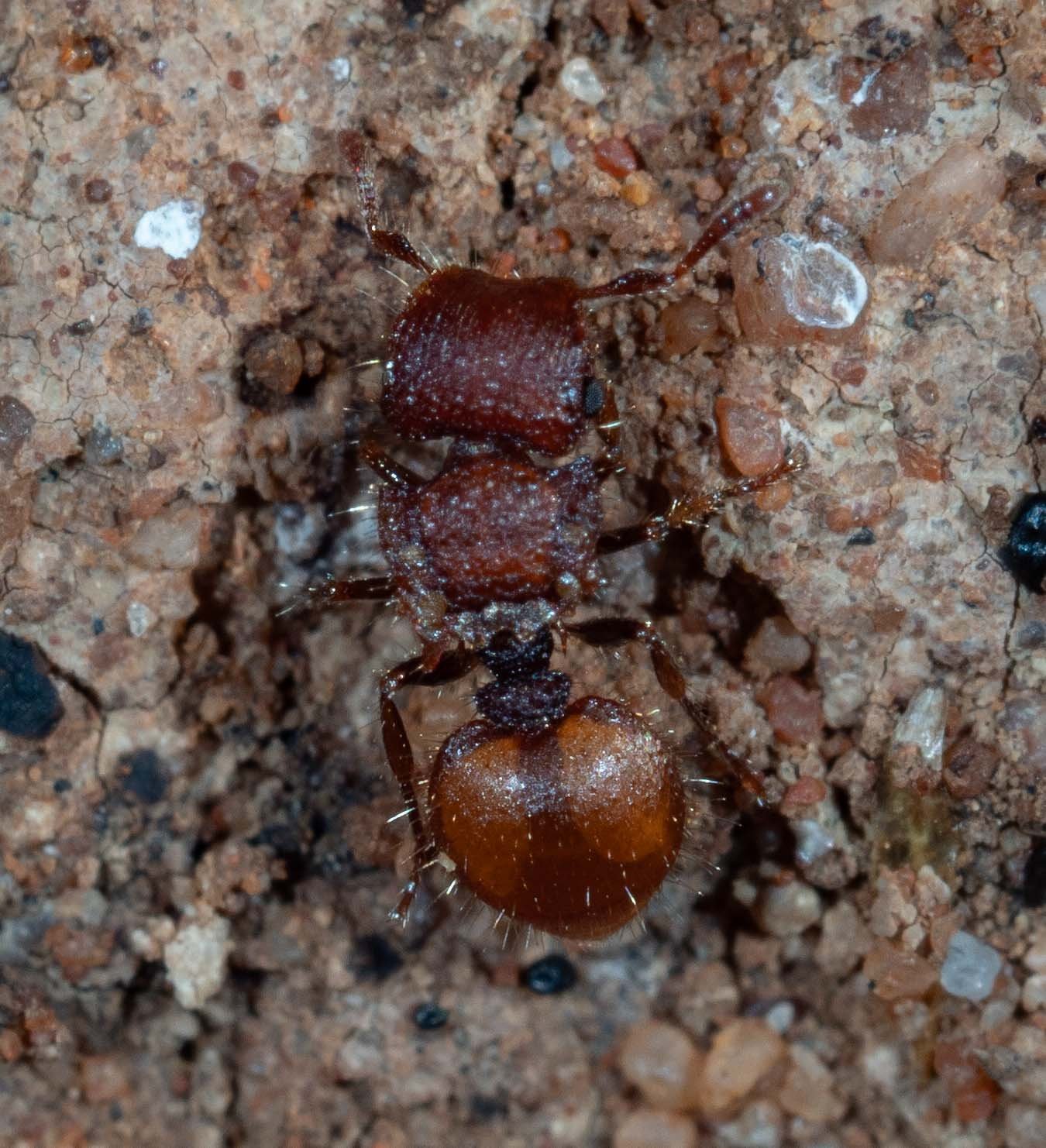
The broad plate covering much of the thorax lends the group their common name of 'shield ants'. It typically overhangs laterally and posteriorly, with various spines and translucent plates, depending upon the particular species.

Meranoplus nest underground in small colonies of around 150 workers. A colony usually has a single queen, but some small colonies may be queenless ... probably satellite nests arising from a 'queenright' colony, which may be many metres away (ref. 6)

Most shield ants are generalist omnivores, foraging on the ground and opportunistically taking seeds (ref. 7).
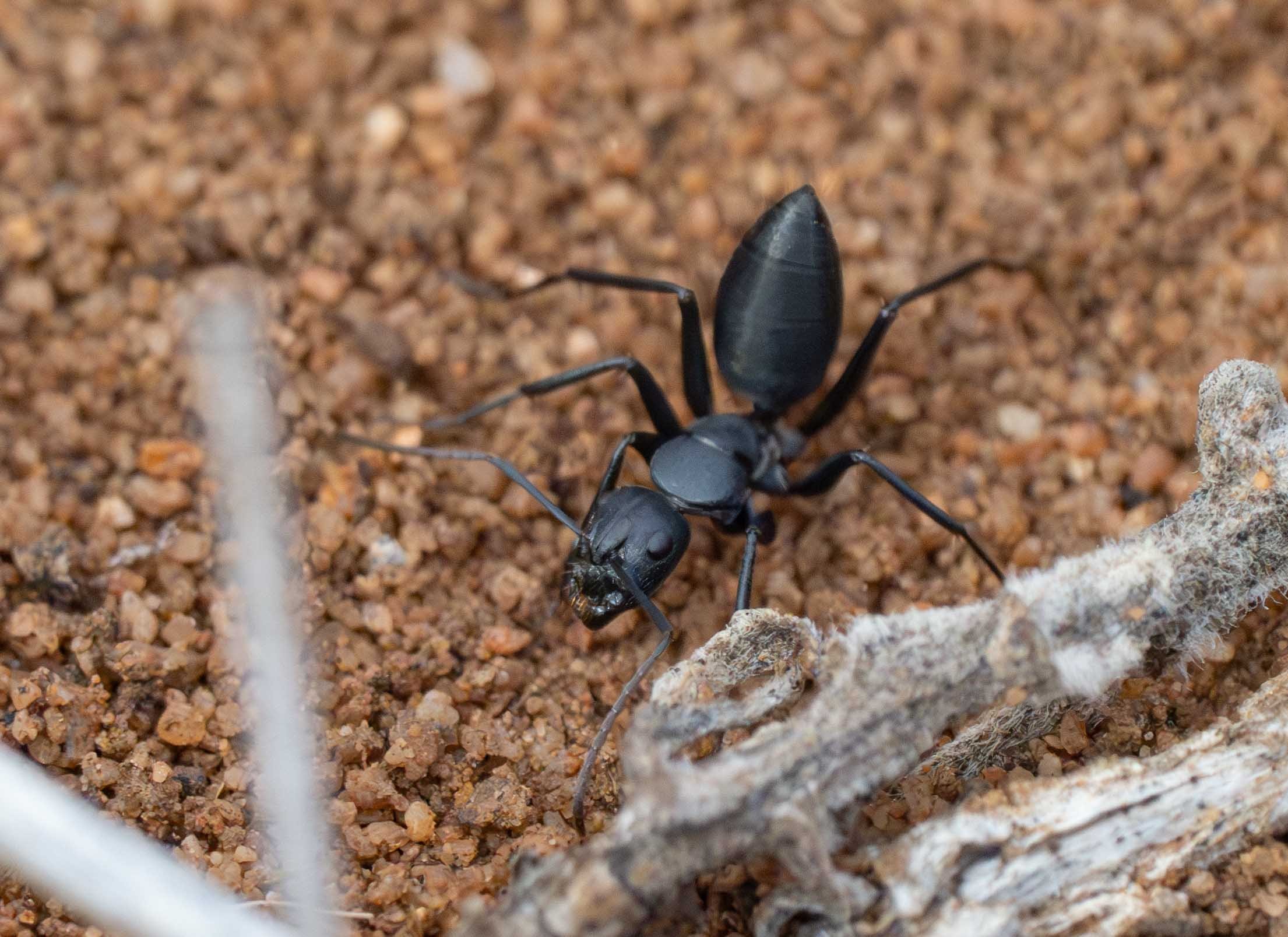
This posture, with abdomen raised vertically, is typical of the species. Despite appearances, they don't sting ... but they can bite.
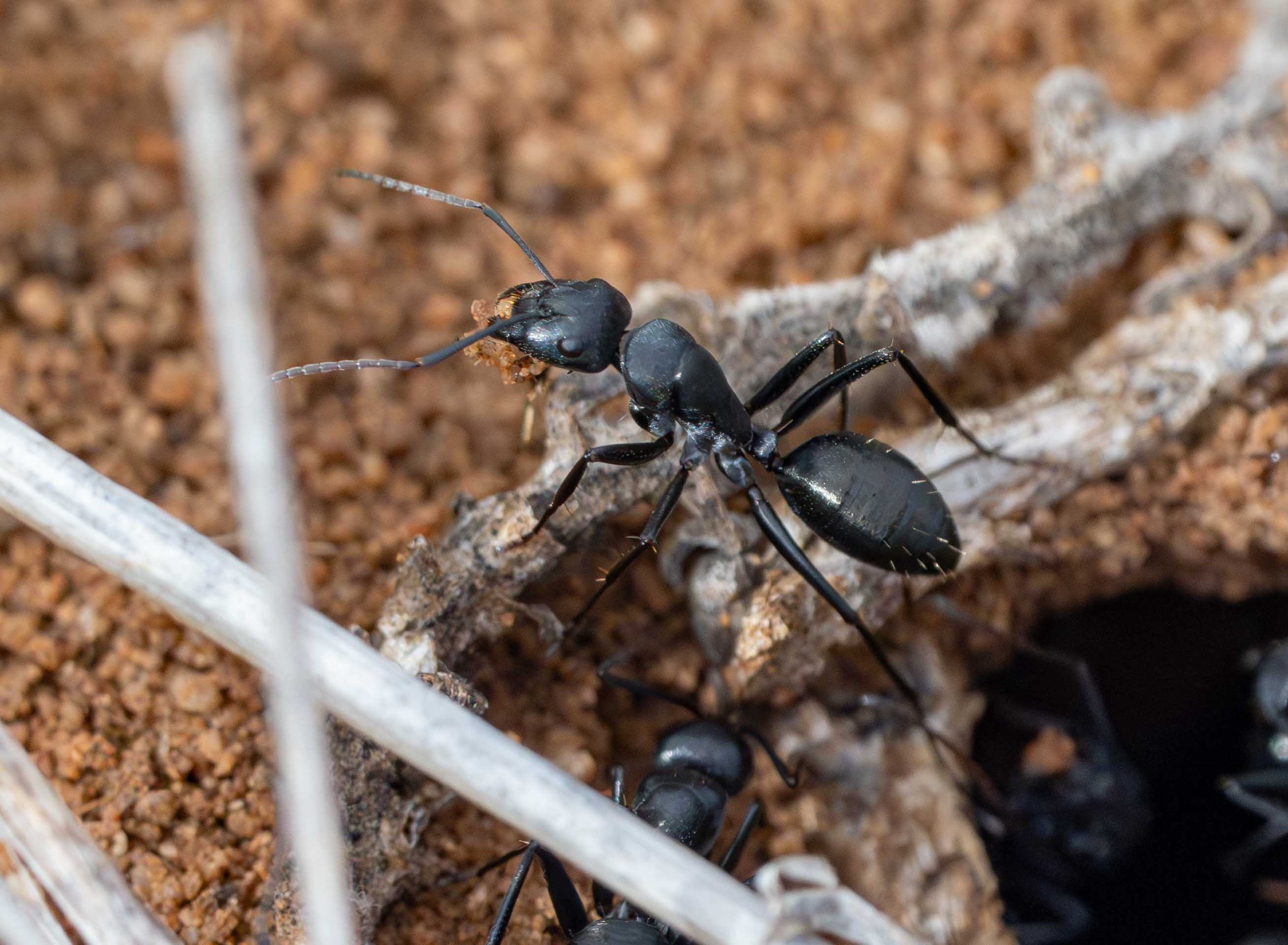
This subspecies is common in arid and semi-arid woodlands across southern Australia (ref. 4).

Some Camponotus species nest in wood ... hence one of their common names, 'Carpenter Ants' ... but this colony was definitely excavating soil. The diggings forming the mound was evidence of a lot of past work.

Excavations ongoing.
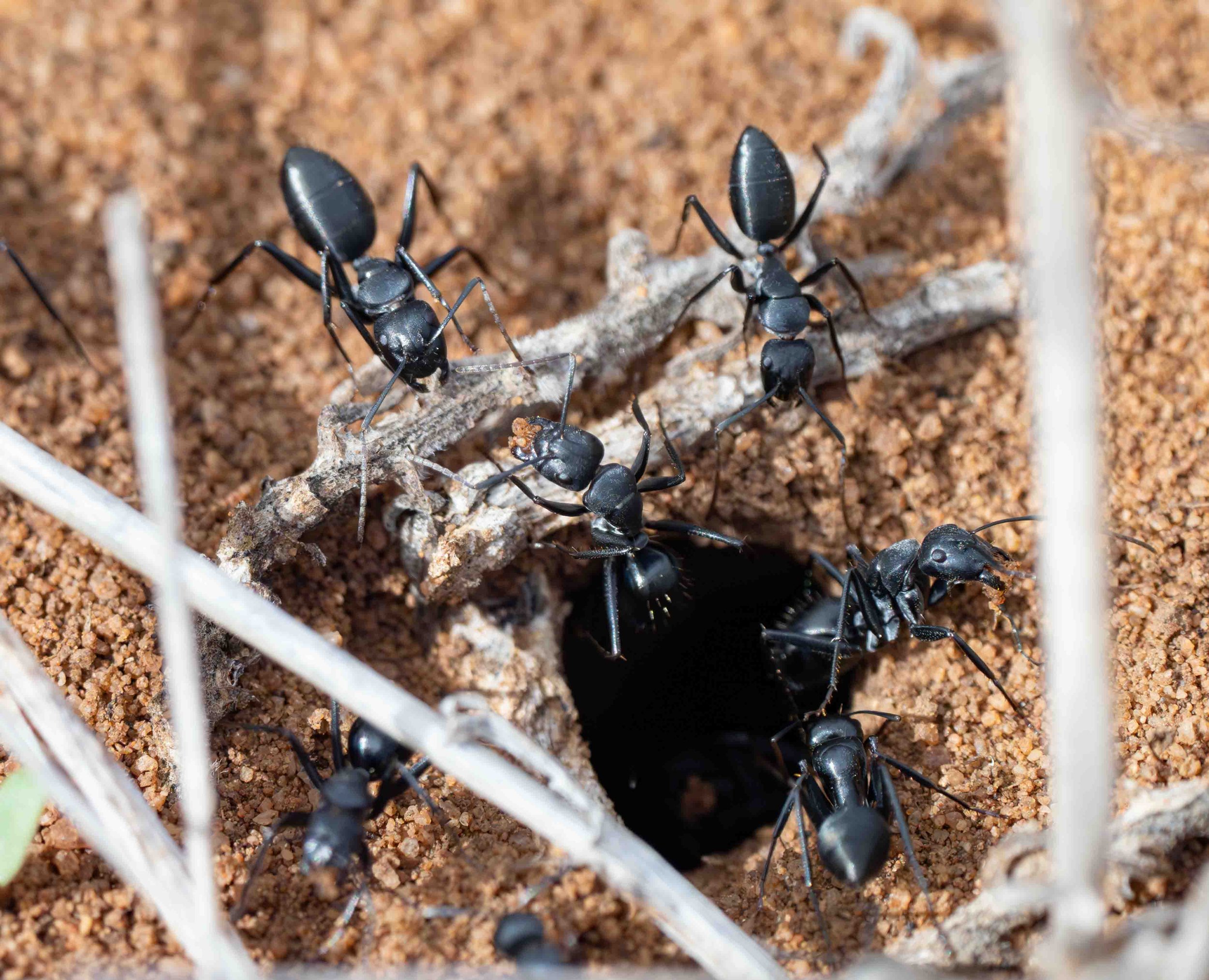

The volcano-like appearance is certainly reminiscent of a funnel-ant nest. But there was just this one mound. And the opening was relatively small.


Might this be the home owner (a species of Camponotus I believe)?
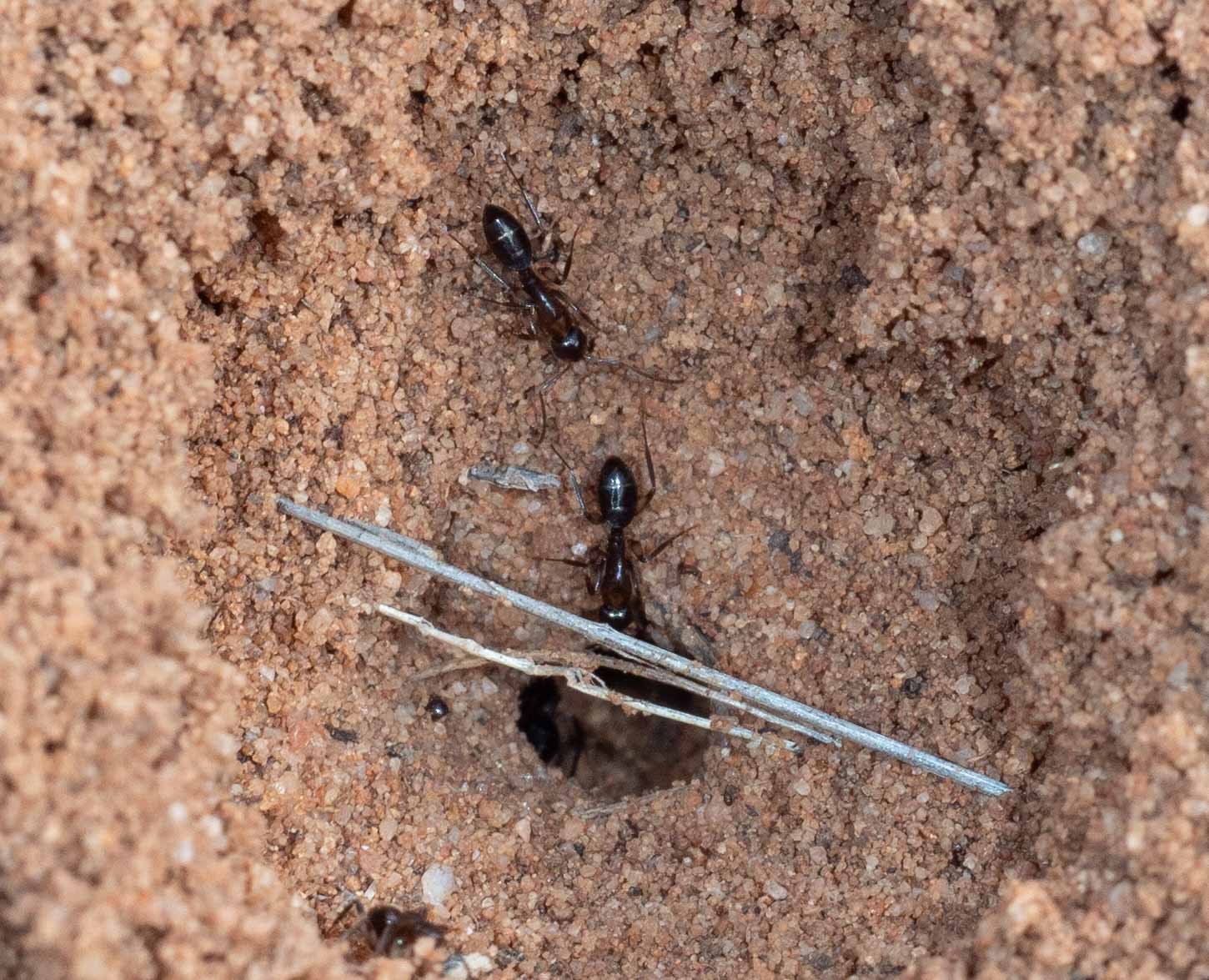
These small, shiny black ants were purposefull moving in and out of the nest. So either they are indeed the rightful homeowners, or they are moving in. Another puzzle I didn't have time to solve. Perhaps an accurate species ID will help. Later.

These distinctive, funnel-shaped nests are instantly identifiable as the work of Aphaenogaster ants.
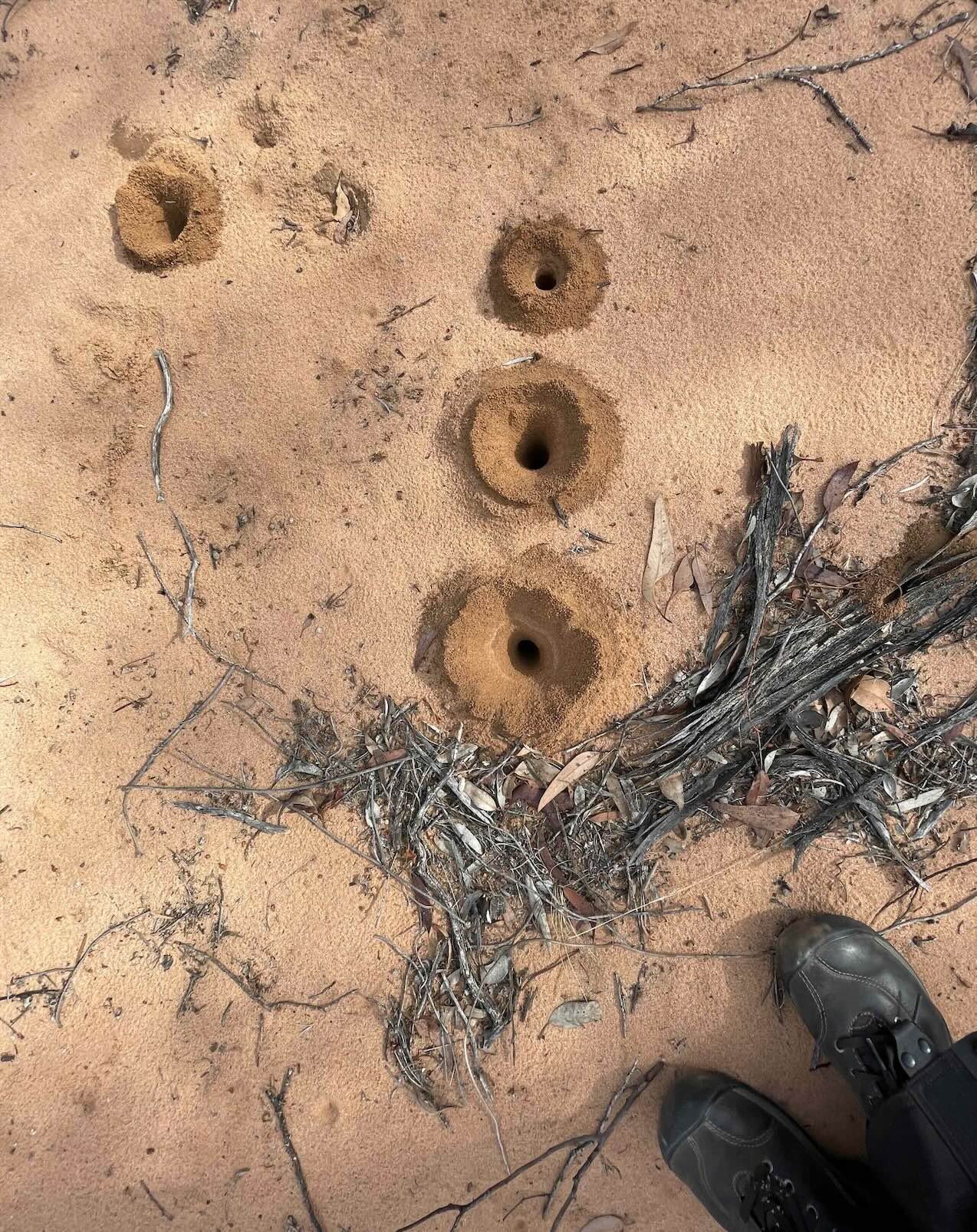
They are large mounds, with very wide, round openings. Here my shoes provide scale (and I don't have small feet!)
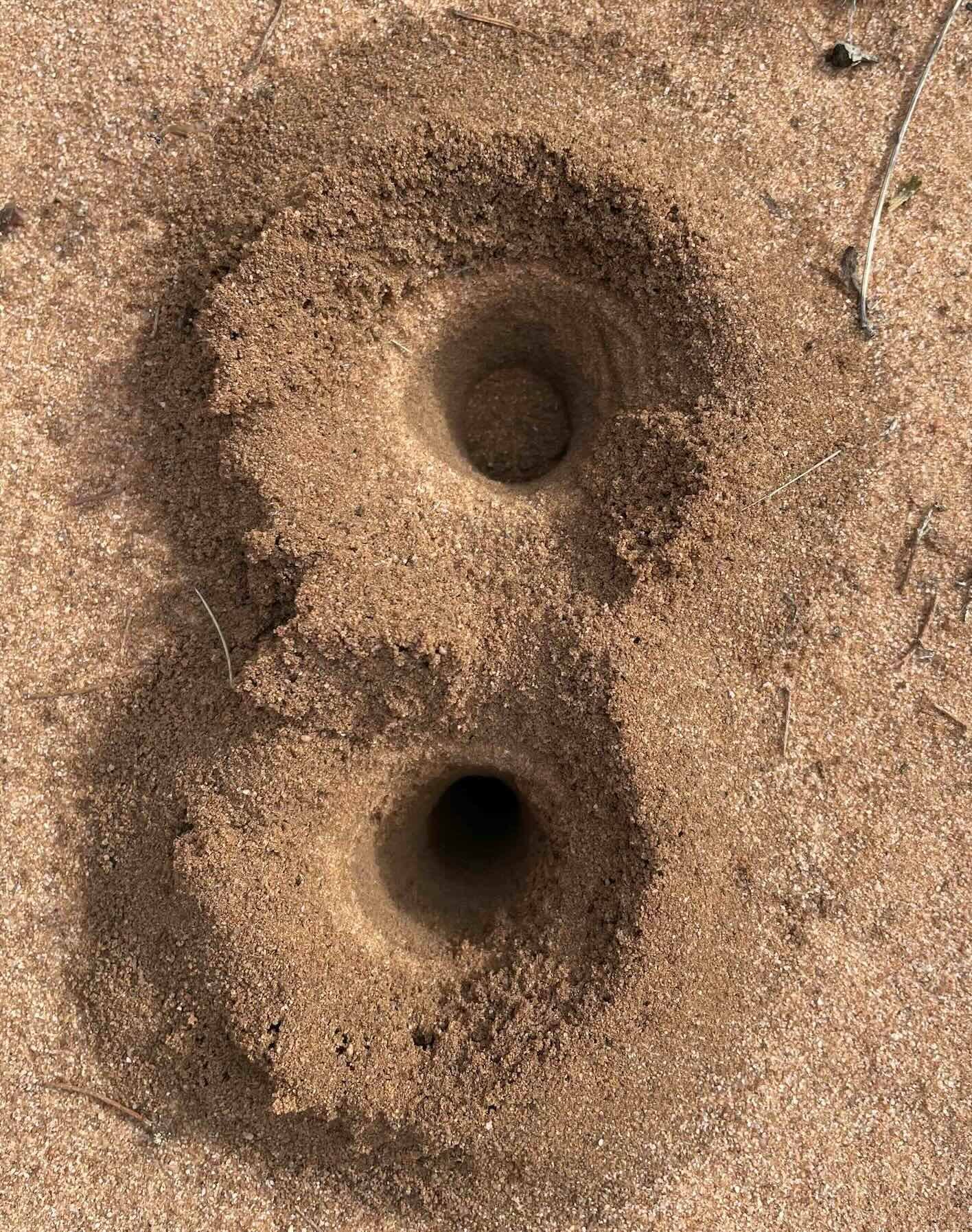
Wandering insects that climb the outer wall are likely to fall directly into the opening ... and become food for colony. I'm not sure why one of these was closed. Perhaps an landslide caused by a passing large animal (not me!). Or maybe the ants sometimes close the burrow from within. A bit of a mystery, for now.
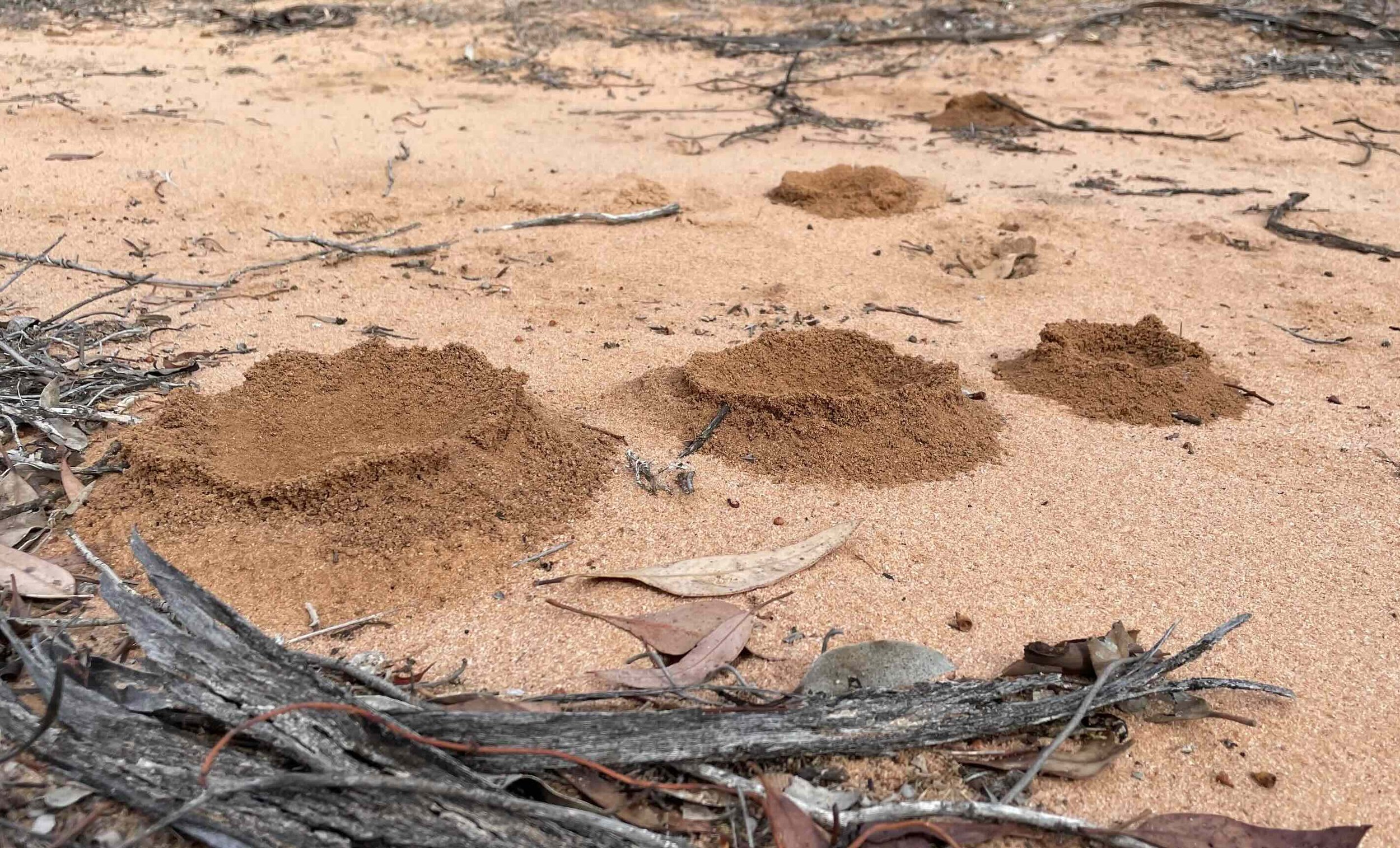
This species is typically found in habitats with at least some trees and shrubs, such as Callitris and mulga (Acacia) woodlands, and mallee (ref. 8). That fits with where I saw these ants, along a trail through quite dense bush.
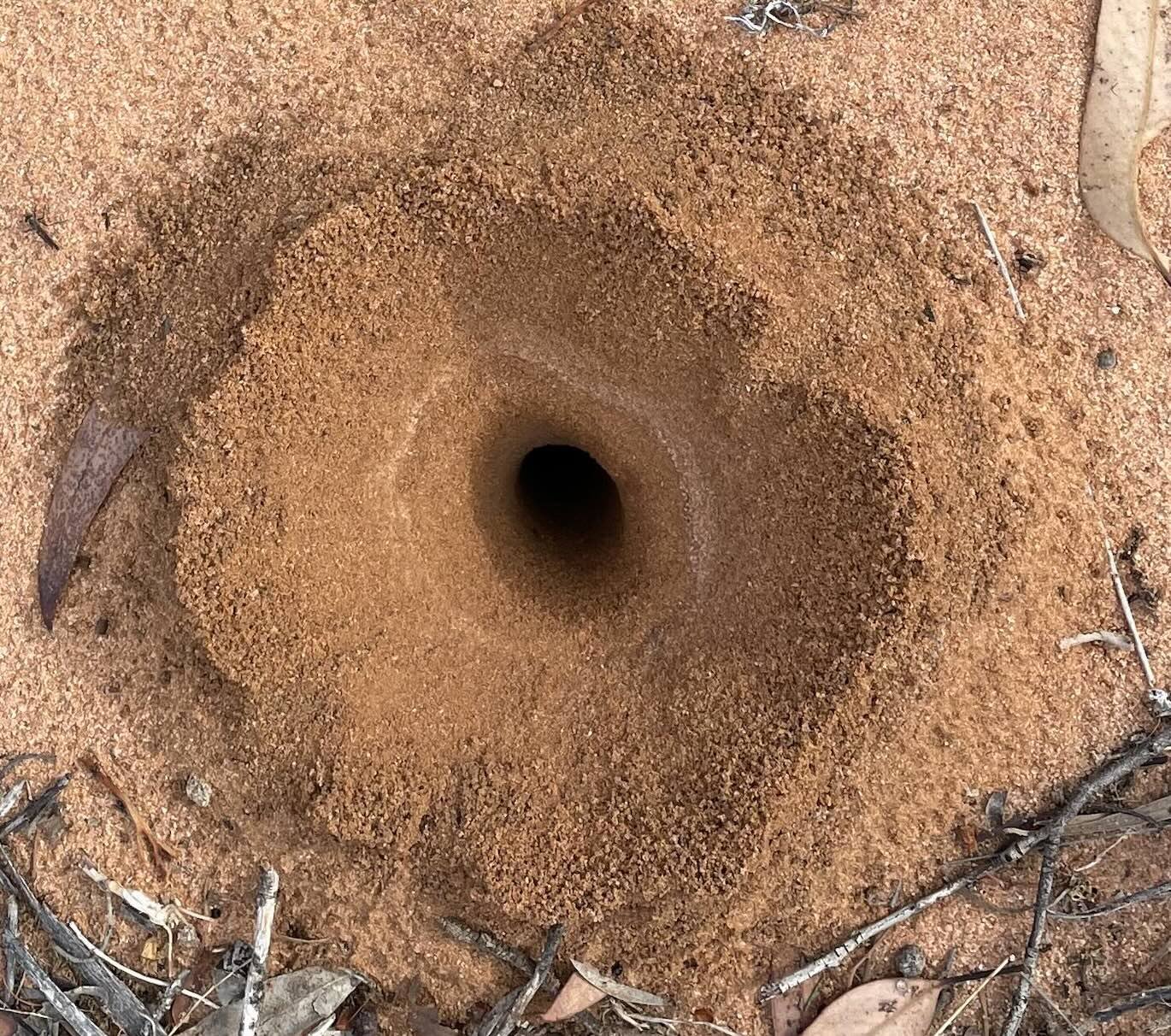
Many mounds ... but not an ant in sight! Apparently this is quite typical for Aphaenogaster (ref. 8). Colonies may be quite large, yet workers are seldom seen above ground ... and even those that venture out do not go far from home. These ants don't need to forage. They tend aphids feeding on plant roots and/or they just wait for food to fall tumble in through the funnel.

Late in the day I came across a large funnel with several workers active at the surface. I collected one for identification.
Australia has eight species of these 'funnel ants'. Aphaenogaster barbigula is found in semi-arid parts of eastern Australia ... including north-western Victoria (ref. 8). The arrangement of hairs beneath the head is a clue to the species identity.
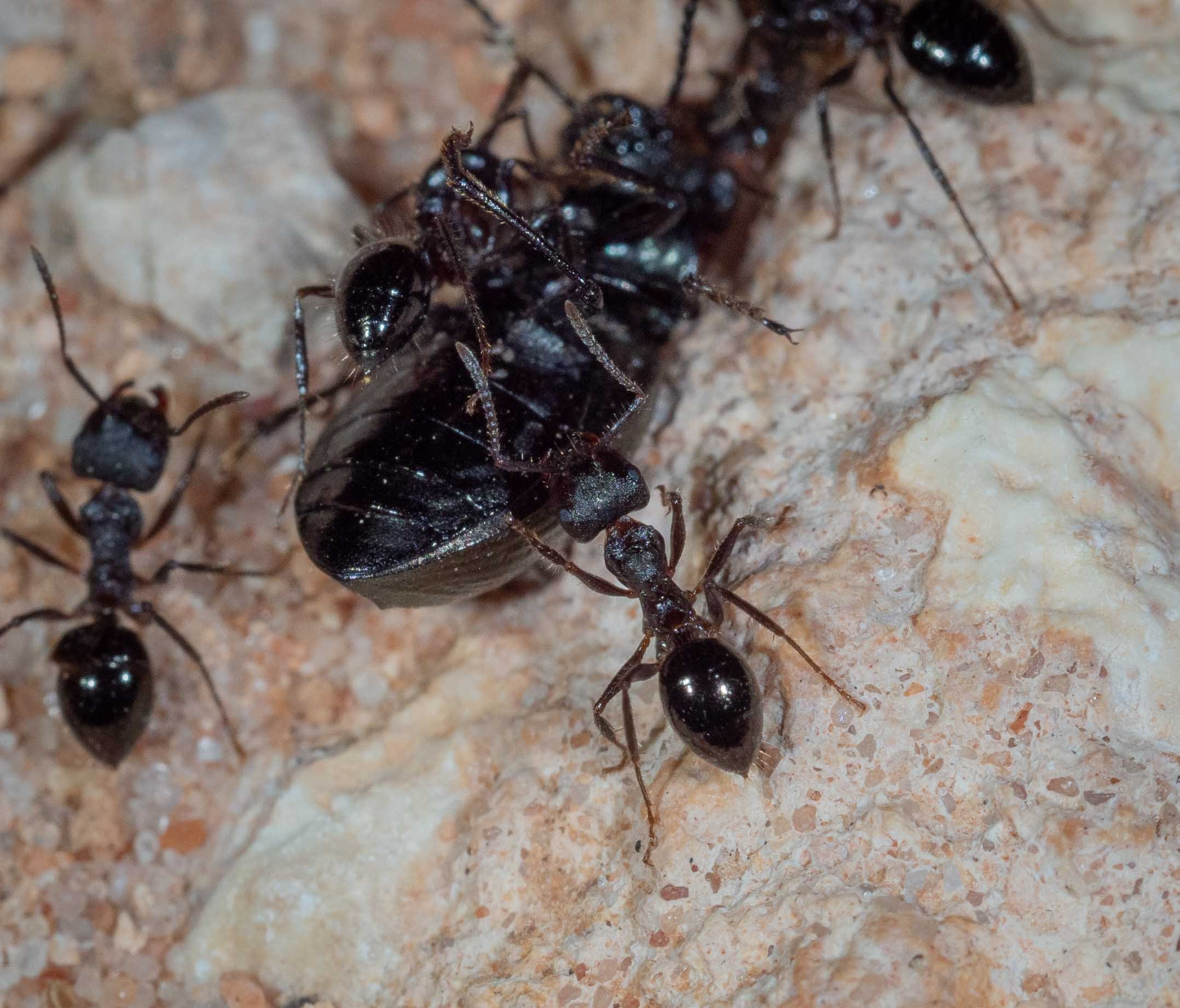
Notoncus are described as general predators, foraging on the ground. These little ants seem a good match, both in behaviour and general appearance.
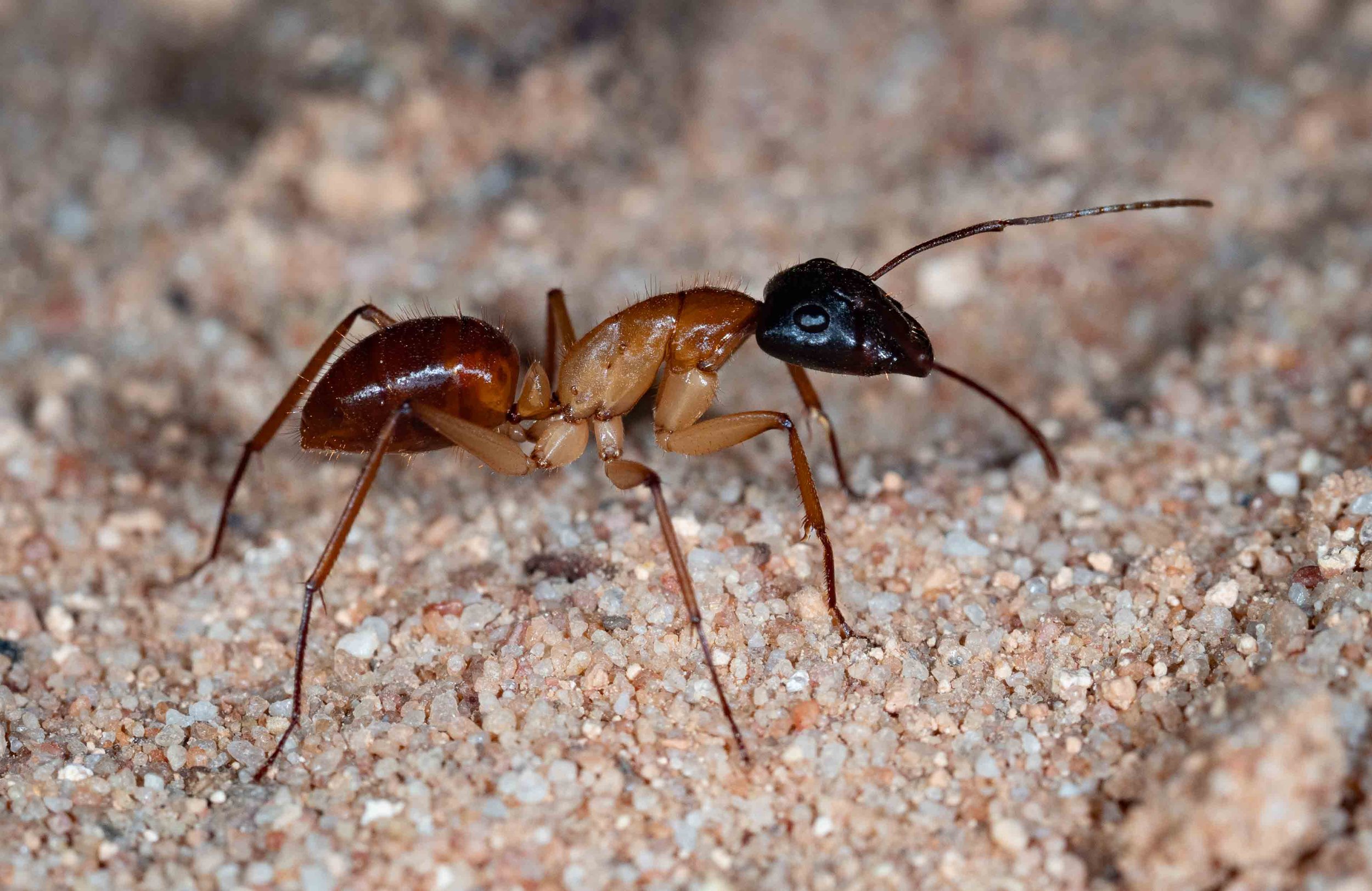
Ants of this genus are commonly called Sugar Ants or Carpenter Ants ... however, the taxon is so large and diverse, these references to their food preferences and nesting habits don't necessarily apply.
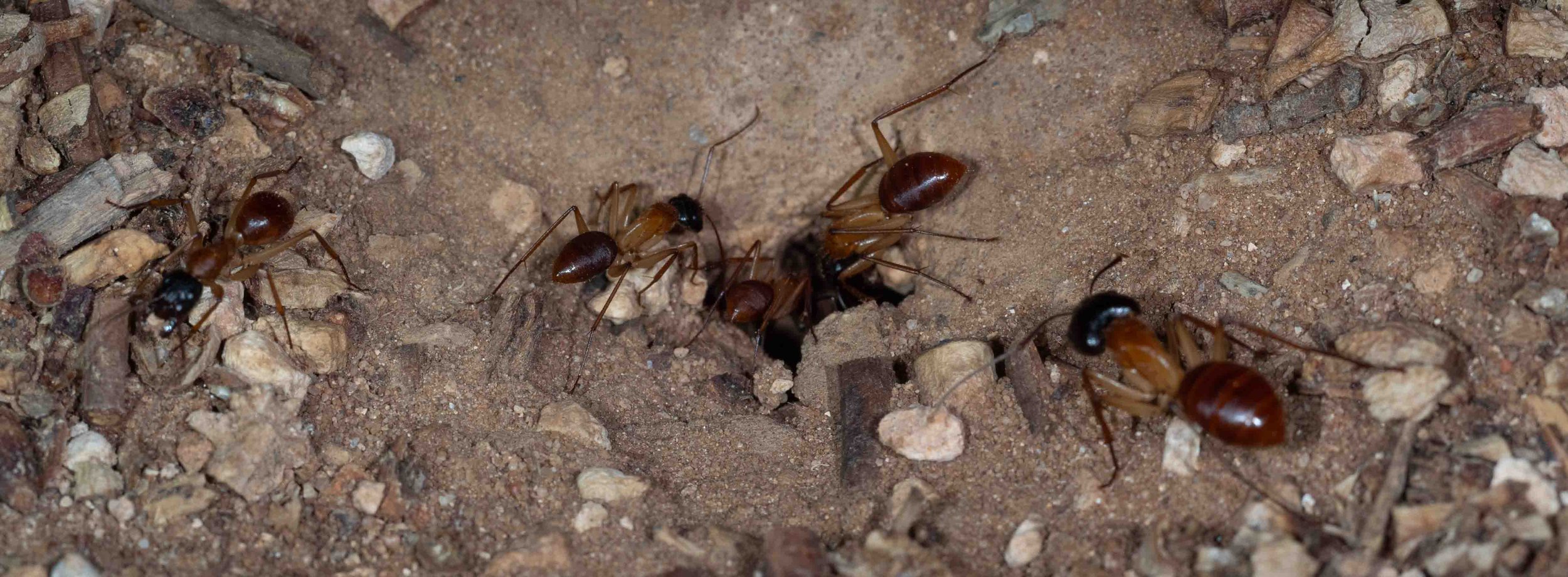
These ants were clearly nesting below ground, rather than inside a piece of wood, so not carpenters at all.
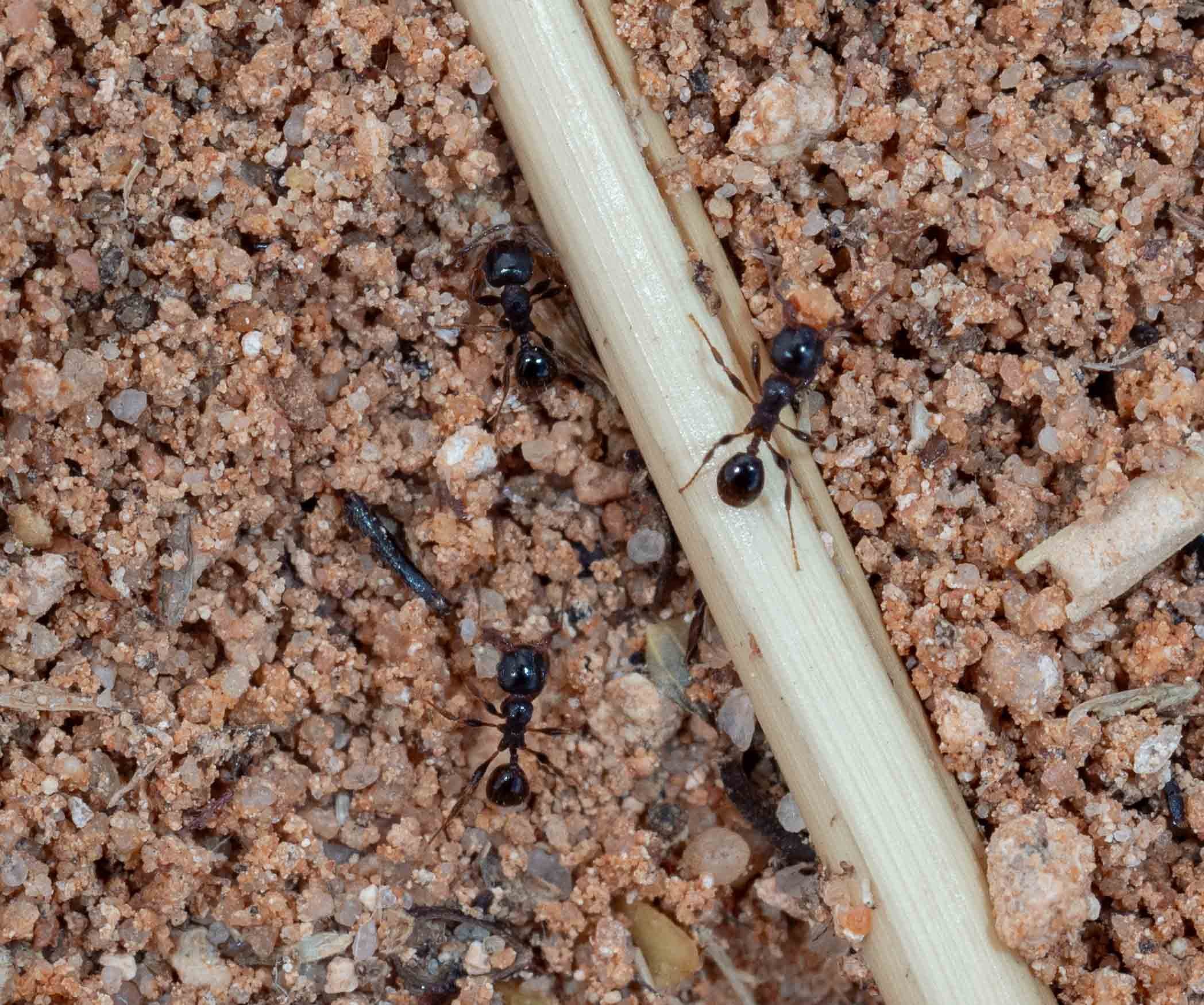
Tiny (<3mm long) and quite slow moving as they carted grains of sand from their nest opening to the small, surrounding mound.
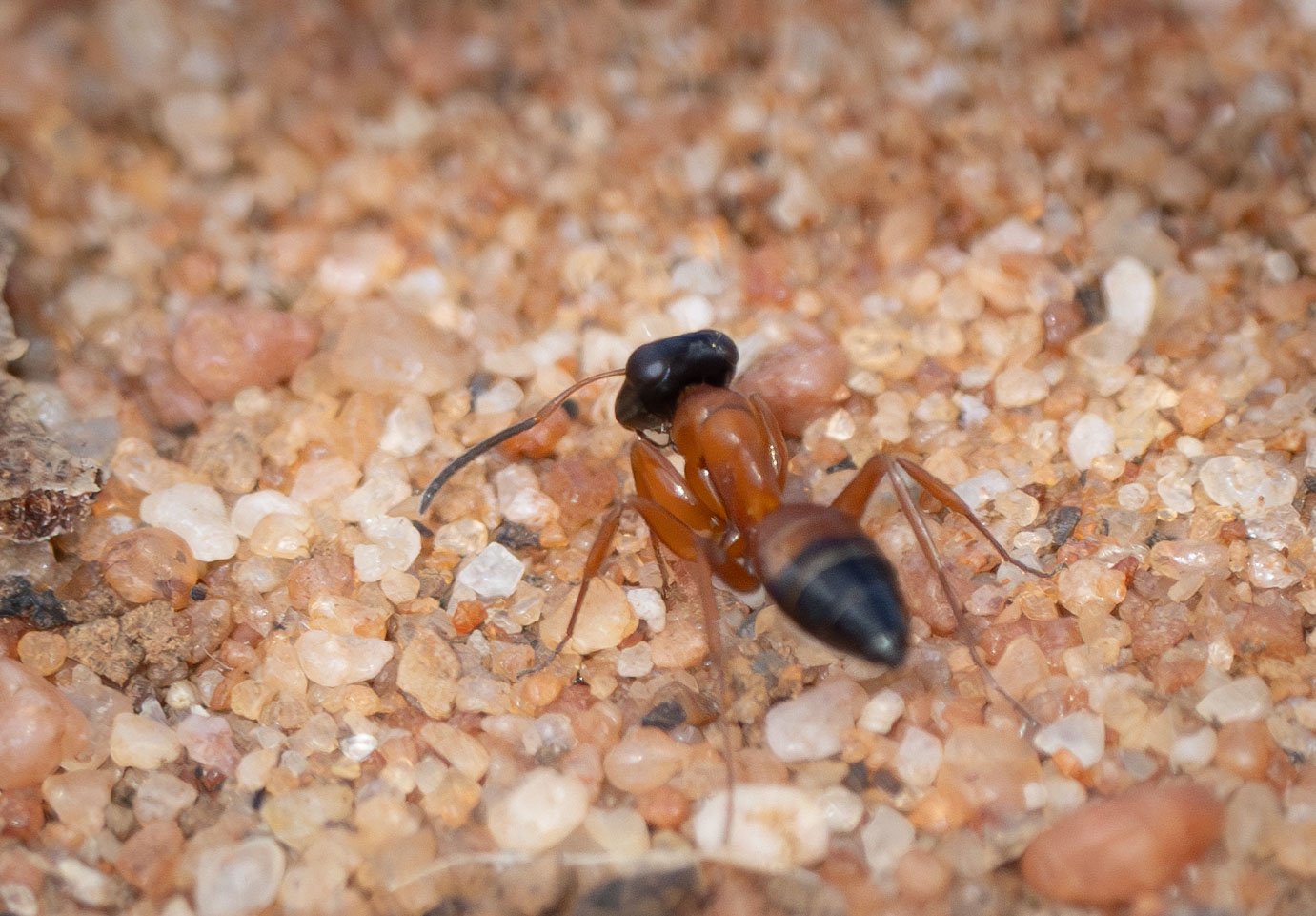
Just one of these sighted.







































